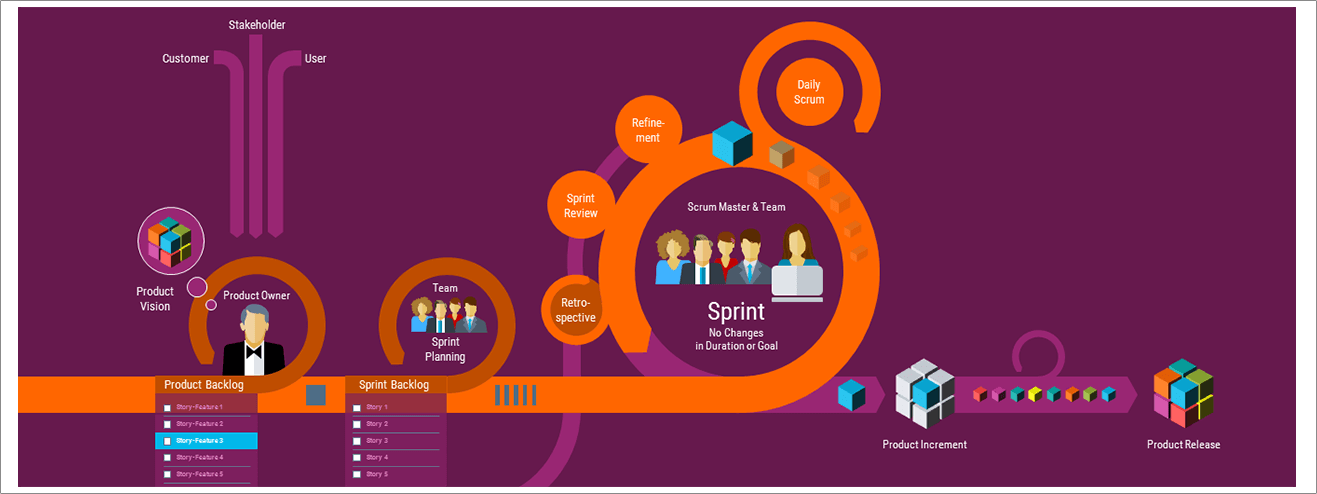Blockchain
One of the most exciting technologies to emerge in the last few years is blockchain.
Our expert blockchain consultants can help leverage this groundbreaking technology for your business, often in creative ways that can truly set you apart from your digitally-bereft competitors.
About Blockchain
Technology
The blockchain refers to a type of digital distributed ledger that keeps track of whatever information or transactions you want. This digital ledger, once created, can keep information in a permanent form.
Blockchain technology initially originated to support the creation of cryptocurrency, the first of which was Bitcoin. Another type of popular cryptocurrency is Ethereum.
Cryptocurrency utilizes blockchain to keep track of transactions, which cuts down on the middleman (such as a bank) that used to be in the way of the transfer of money.
Blockchain technology works great for digital currency, but that is just the beginning. The blockchain has many other potential applications, including:
As you can see, blockchain is already leading to tremendous technology transformation in a variety of industries, governments, and academic institutions. Your business can potentially take advantage of this emerging technology to create profound digital transformation at all levels of the organization.
Blockchain
Consulting Services
Our blockchain consulting services are comprehensive and based on a holistic viewpoint. Whether you need Hyperledger Consultancy or are looking to utilize Ethereum for an application, we can help. Our team of blockchain experts assesses your technology needs and infrastructure to help best integrate blockchain into your business.

Strategic Digital Architecture Service Design, Development, and Deployment in Healthcare, Bioscience, Logistics, Energy and Supply Chain Domestic and International
We live in a time where technology is changing every aspect of our business, creating new digital ecosystems that did not exist, as well as new dimensions of risk which must be managed.
As business leaders we know you must strive to embrace digital technologies as a source of growth providing you the ability to compete on a scale never before witnessed in human history.
The need to act now – to design, to assess, to architect and develop new applications has never been greater. These actions will drive even further successful business outcomes.
Agile Sprint Design workshops
Workshops for Blockchain, DLT, Integrated Development
Environments, and Modern Relational database activities

What is Agile Innovation, and what is our Sprint Design? It’s a framework and a set of tools and techniques that combine a rigorous approach to innovation management in an adaptive framework, thus enabling you to make rapid innovation progress in a dynamic and fast-changing competitive landscape. All of which has, of course, become increasingly important in these challenging times of such great turbulence and uncertainty. What is a design sprint?
A design sprint is a six-step process framework that helps address critical business questions through proven approaches including ethnography, design thinking, rapid prototyping, user testing, enhanced storytelling technique, and innovation process evolution. The goal is to assist innovation teams to gain key realizations and reaching clearly defined goals and deliverables effectively and efficiently.
Blockchain Lab Design
Use Case, Feature Set Analysis, and Development
In their determination to develop and articulate a better way they wrote a simple document entitled “The Manifesto for Agile Software Development.” It was comprised of four simple (but also not so simple) statements:
We are uncovering better ways of developing software by doing it and helping others do it. Through this work, we have come to value:
- Individuals and interactions over processes and tools
- Working software over comprehensive documentation
- Customer collaboration over contract negotiation
- Responding to change over following a plan
Since Agile was invented specifically to address software programming projects, you might logically infer that its principles and practices are useful only or primarily in technology, but in fact the relevance of Agile is much broader.

It has proven to be so brilliantly simple a way to organize people to get useful work done that its use is rapidly spreading beyond software into many other creative realms. Its insights and methods are applicable to nearly every kind of complex project that involves creativity and uncertainty, and hence it is legitimately the core of an approach that is proving to be nearly universal. As a result, Agile is being used everywhere today, and for a very good reason: it actually works. It’s used by companies like Apple, Alibaba, Google, Facebook and Tesla.
The new values, principles, practices, and benefits are a radical alternative to command and-control-style management. National Public Radio employs Agile methods to create new programming. John Deere uses them to develop new machines, and Saab to produce new fighter jets. C.H. Robinson, a global third-party logistics provider, applies them in human resources. And GE relies on Agile technique to transition itself from 20th century conglomerate to 21st-century “digital industrial company.” By taking people out of their functional silos and putting them in self-managed and customer-focused multidisciplinary teams, the Agile approach is not only increasing productivity, but also helping to train the next generation of corporate leaders – you are the next generation now.

Operational
Efficiency Analysis
Operational efficiency encompasses several strategies and techniques used to accomplish the basic goal of delivering quality goods to customers in the most cost-effective and timely manner. Resource utilization, production, distribution and inventory management are all common aspects of operational efficiency.
The most critical factors vary by the nature of the business manufacturing, distribution or retail. Your small business must have exceptional efficiency to compete with larger companies with greater economies of scale and bargaining power with vendors.
Business Plan development
and Analysis, go to Market
When we work with Innovation Centers, Corporate Partners and advise startup entrepreneurs, we follow a well-defined method for clarifying, testing and validating the business model – before going to market and spending thousands or tens of thousands of dollars (or millions) on prototyping and/or marketing.
The method looks like this (We’ll describe each step in detail):
Capital Ladder development
Spark Capital, Seed, Pre-Series A,
Long Term Capital Formation
Startups seeking financing often turn to venture capital (VC) firms. These firms can provide capital; strategic assistance; introductions to potential customers, partners, and employees; and much more.
Venture capital financings are not easy to obtain or close. Entrepreneurs will be better prepared to obtain venture capital financing if they understand the process, the anticipated deal terms, and the potential issues that will arise. In our firm we provide an overview of venture capital financings. As well one must understand the Capital Ladder formation, from “Spark Capital,” FNR, Pre-seed, Seed, Pre-Series A, A and so on. We can help and assist you with this process, tie you in with multiple financing partners, and guide you through the decision matrix.
Cybersecurity, risk management
Frameworks and development
Cybersecurity threats are on the rise and only getting more dangerous. It seems every day there’s a new headline about another data breach. And it’s no longer only large enterprises that must be concerned. Recent ransomware incidents have shown that small and medium-size businesses are also highly vulnerable to today’s threats, and the impact can be enormous. If infected by ransomware, you may be forced to pay tens of thousands of dollars to get your data back. And the average cost of a data breach is now over $5.9 million and rising.
However, most organizations don’t have the technology or personnel to even detect these emerging cybersecurity threats. In fact, the average time between a data breach and discovery is 205 days – that’s over 7 months! Simply implementing security tools such as firewalls or anti-virus isn’t enough. This is even more true for organizations that fall under PCI, HIPPA, SOX, or FFIEC regulations. For those companies, compliance with various guidelines and mandates is absolutely critical to avoid fines or worse.
Today’s threats and compliance guidelines require organizations of all sizes to collect, correlate, and analyze security information from all IT systems to enable rapid detection and remediation. That technology is known as security information and event management (SIEM), and it provides deep security intelligence for your IT environment. A proper SIEM solution combined with human oversight by an expert Security Operations Center can help answer critical questions that are vital to your cybersecurity protection. Our firm takes the important step to insure you have a secure framework, we help you understand your tools to protect your investment, and can step into the future with assurance your digital corporate environment is more risk averse and safe.
